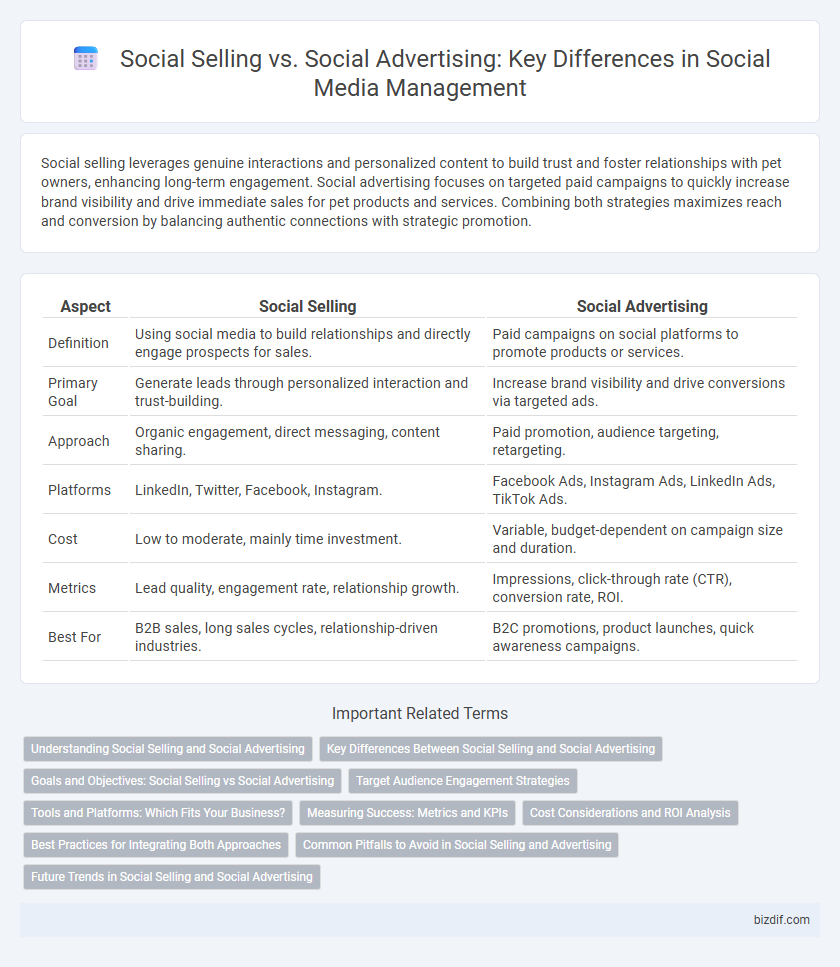Social selling leverages genuine interactions and personalized content to build trust and foster relationships with pet owners, enhancing long-term engagement. Social advertising focuses on targeted paid campaigns to quickly increase brand visibility and drive immediate sales for pet products and services. Combining both strategies maximizes reach and conversion by balancing authentic connections with strategic promotion.
Table of Comparison
| Aspect | Social Selling | Social Advertising |
|---|---|---|
| Definition | Using social media to build relationships and directly engage prospects for sales. | Paid campaigns on social platforms to promote products or services. |
| Primary Goal | Generate leads through personalized interaction and trust-building. | Increase brand visibility and drive conversions via targeted ads. |
| Approach | Organic engagement, direct messaging, content sharing. | Paid promotion, audience targeting, retargeting. |
| Platforms | LinkedIn, Twitter, Facebook, Instagram. | Facebook Ads, Instagram Ads, LinkedIn Ads, TikTok Ads. |
| Cost | Low to moderate, mainly time investment. | Variable, budget-dependent on campaign size and duration. |
| Metrics | Lead quality, engagement rate, relationship growth. | Impressions, click-through rate (CTR), conversion rate, ROI. |
| Best For | B2B sales, long sales cycles, relationship-driven industries. | B2C promotions, product launches, quick awareness campaigns. |
Understanding Social Selling and Social Advertising
Social selling leverages personal connections and trust-building on platforms like LinkedIn and Instagram to engage prospects and nurture relationships, leading to higher conversion rates and long-term customer loyalty. Social advertising uses paid campaigns on Facebook, Twitter, and TikTok to boost brand visibility and target specific demographics with tailored messages, driving immediate traffic and sales. Mastering both strategies optimizes customer acquisition by combining authentic engagement with targeted outreach.
Key Differences Between Social Selling and Social Advertising
Social selling involves building relationships and engaging directly with potential customers on platforms like LinkedIn and Instagram to drive organic sales, whereas social advertising uses paid campaigns on channels such as Facebook Ads and Twitter Ads to reach a broader audience quickly. Social selling relies on personalized interactions and trust-building, while social advertising focuses on targeting specific demographics and generating immediate conversions through sponsored content. Understanding these key differences helps businesses allocate budgets effectively between long-term relationship-building and short-term promotional goals.
Goals and Objectives: Social Selling vs Social Advertising
Social selling focuses on building relationships and trust with potential customers by engaging directly through personalized content and conversations, aiming to drive long-term sales growth and customer loyalty. Social advertising prioritizes targeted campaigns and paid promotions designed to increase brand awareness, generate leads quickly, and boost immediate conversions. Understanding these distinct goals helps businesses allocate resources effectively to maximize both engagement and return on investment in social media strategies.
Target Audience Engagement Strategies
Social selling leverages personalized interactions and relationship building to engage a targeted audience authentically, fostering trust and long-term customer loyalty through direct communication on platforms like LinkedIn and Instagram. Social advertising uses data-driven campaigns and precise targeting tools, such as Facebook Ads Manager and Google AdWords, to deliver tailored content at scale, maximizing reach and conversion rates through paid promotions. Both strategies play crucial roles in optimizing audience engagement by combining organic relationship cultivation with strategic paid outreach to drive sales and brand awareness.
Tools and Platforms: Which Fits Your Business?
Social selling primarily leverages platforms like LinkedIn Sales Navigator and Hootsuite to engage prospects directly through personalized interactions and relationship building. Social advertising relies on tools such as Facebook Ads Manager and Google Ads for targeted campaigns that drive immediate traffic and conversions. Choosing between these depends on your business goal--social selling suits businesses focusing on long-term customer relationships, while social advertising fits those aiming for rapid brand awareness and sales.
Measuring Success: Metrics and KPIs
Social selling success is measured through engagement metrics such as lead conversion rates, customer interactions, and relationship-building effectiveness on platforms like LinkedIn and Instagram. Social advertising relies on KPIs like click-through rates (CTR), return on ad spend (ROAS), cost per acquisition (CPA), and overall reach to evaluate campaign performance. Tracking these metrics helps marketers optimize strategies by aligning social selling's focus on relationship-driven outcomes with social advertising's emphasis on direct response metrics.
Cost Considerations and ROI Analysis
Social selling leverages personalized interactions on platforms like LinkedIn and Instagram, often resulting in lower upfront costs but requiring significant time investment to build trust and relationships. Social advertising involves paid campaigns on Facebook, Twitter, and TikTok, offering immediate reach with defined budgets and measurable ROI using tools like Facebook Ads Manager and Google Analytics. Evaluating ROI for social selling centers on long-term customer lifetime value and engagement metrics, whereas social advertising ROI relies on click-through rates, conversion rates, and direct sales attribution.
Best Practices for Integrating Both Approaches
Integrating social selling and social advertising involves aligning personalized engagement with targeted ad campaigns to maximize conversion rates and brand visibility. Best practices include using social ads to generate leads while empowering social sellers to nurture relationships through authentic interactions and timely follow-ups. Leveraging data analytics to synchronize messaging and audience segmentation enhances overall effectiveness and ROI in multi-channel social media strategies.
Common Pitfalls to Avoid in Social Selling and Advertising
Common pitfalls in social selling include neglecting genuine engagement and overemphasizing direct sales pitches, which can alienate potential customers and reduce trust. In social advertising, ineffective targeting and ignoring data analytics often lead to wasted budget and low ROI. Avoiding these mistakes by focusing on authentic interactions and data-driven ad strategies maximizes the effectiveness of both social selling and advertising efforts.
Future Trends in Social Selling and Social Advertising
Future trends in social selling emphasize personalized customer interactions powered by AI-driven insights and automation tools that foster authentic engagement. Social advertising is shifting towards immersive experiences through augmented reality (AR) and advanced targeting algorithms that optimize ad performance and conversion rates. The convergence of social selling and advertising leverages data analytics to create seamless buyer journeys across multi-platform ecosystems.
Social selling vs Social advertising Infographic

 bizdif.com
bizdif.com